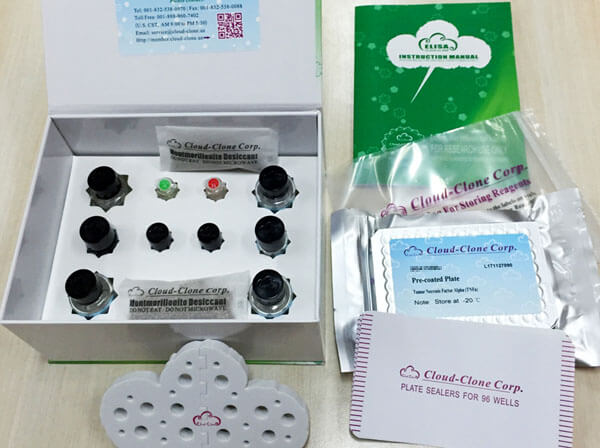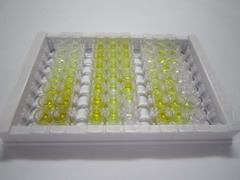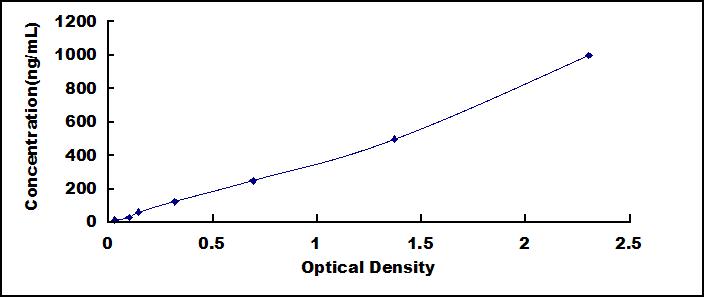ELISA Kit for Aspartate Aminotransferase (AST) 

cCAT; AAT; ASAT; SGOT; GOT1; Cysteine transaminase, cytoplasmic; Transaminase A; Aspartate Transaminase 1,Cytoplasmic; Glutamic-Oxaloacetic Transaminase 1,Soluble
- UOM
- FOB US$ 466.00 US$ 665.00 US$ 2,993.00 US$ 5,653.00 US$ 46,550.00
- Quantity
Overview
Properties
- Product No.SEB214Hu
- Organism SpeciesHomo sapiens (Human) Same name, Different species.
- ApplicationsEnzyme-linked immunosorbent assay for Antigen Detection.
Research use only - DownloadInstruction Manual
- CategoryEnzyme & KinaseTumor immunityInfection immunityHepatology
Sign into your account
Share a new citation as an author
Upload your experimental result
Review

Contact us
Please fill in the blank.
Recovery
Matrices listed below were spiked with certain level of recombinant Aspartate Aminotransferase (AST) and the recovery rates were calculated by comparing the measured value to the expected amount of Aspartate Aminotransferase (AST) in samples.
| Matrix | Recovery range (%) | Average(%) |
| serum(n=5) | 98-105 | 102 |
| EDTA plasma(n=5) | 84-103 | 101 |
| heparin plasma(n=5) | 95-104 | 101 |
Precision
Intra-assay Precision (Precision within an assay): 3 samples with low, middle and high level Aspartate Aminotransferase (AST) were tested 20 times on one plate, respectively.
Inter-assay Precision (Precision between assays): 3 samples with low, middle and high level Aspartate Aminotransferase (AST) were tested on 3 different plates, 8 replicates in each plate.
CV(%) = SD/meanX100
Intra-Assay: CV<10%
Inter-Assay: CV<12%
Linearity
The linearity of the kit was assayed by testing samples spiked with appropriate concentration of Aspartate Aminotransferase (AST) and their serial dilutions. The results were demonstrated by the percentage of calculated concentration to the expected.
| Sample | 1:2 | 1:4 | 1:8 | 1:16 |
| serum(n=5) | 89-101% | 94-102% | 81-89% | 87-101% |
| EDTA plasma(n=5) | 80-103% | 89-98% | 86-94% | 79-101% |
| heparin plasma(n=5) | 83-97% | 97-105% | 93-101% | 93-101% |
Stability
The stability of kit is determined by the loss rate of activity. The loss rate of this kit is less than 5% within the expiration date under appropriate storage condition.
To minimize extra influence on the performance, operation procedures and lab conditions, especially room temperature, air humidity, incubator temperature should be strictly controlled. It is also strongly suggested that the whole assay is performed by the same operator from the beginning to the end.
Reagents and materials provided
| Reagents | Quantity | Reagents | Quantity |
| Pre-coated, ready to use 96-well strip plate | 1 | Plate sealer for 96 wells | 4 |
| Standard | 2 | Standard Diluent | 1×20mL |
| Detection Reagent A | 1×120µL | Assay Diluent A | 1×12mL |
| Detection Reagent B | 1×120µL | Assay Diluent B | 1×12mL |
| TMB Substrate | 1×9mL | Stop Solution | 1×6mL |
| Wash Buffer (30 × concentrate) | 1×20mL | Instruction manual | 1 |
Assay procedure summary
1. Prepare all reagents, samples and standards;
2. Add 100µL standard or sample to each well. Incubate 1 hours at 37°C;
3. Aspirate and add 100µL prepared Detection Reagent A. Incubate 1 hour at 37°C;
4. Aspirate and wash 3 times;
5. Add 100µL prepared Detection Reagent B. Incubate 30 minutes at 37°C;
6. Aspirate and wash 5 times;
7. Add 90µL Substrate Solution. Incubate 10-20 minutes at 37°C;
8. Add 50µL Stop Solution. Read at 450nm immediately.

Test principle
The test principle applied in this kit is Sandwich enzyme immunoassay. The microtiter plate provided in this kit has been pre-coated with an antibody specific to Aspartate Aminotransferase (AST). Standards or samples are then added to the appropriate microtiter plate wells with a biotin-conjugated antibody specific to Aspartate Aminotransferase (AST). Next, Avidin conjugated to Horseradish Peroxidase (HRP) is added to each microplate well and incubated. After TMB substrate solution is added, only those wells that contain Aspartate Aminotransferase (AST), biotin-conjugated antibody and enzyme-conjugated Avidin will exhibit a change in color. The enzyme-substrate reaction is terminated by the addition of sulphuric acid solution and the color change is measured spectrophotometrically at a wavelength of 450nm ± 10nm. The concentration of Aspartate Aminotransferase (AST) in the samples is then determined by comparing the O.D. of the samples to the standard curve.
Giveaways
Increment services
-
 Single-component Reagents of Assay Kit
Single-component Reagents of Assay Kit
-
 Lysis Buffer Specific for ELISA / CLIA
Lysis Buffer Specific for ELISA / CLIA
-
 Quality Control of Kit
Quality Control of Kit
-
 ELISA Kit Customized Service
ELISA Kit Customized Service
-
 Disease Model Customized Service
Disease Model Customized Service
-
 Serums Customized Service
Serums Customized Service
-
 TGFB1 Activation Reagent
TGFB1 Activation Reagent
-
 Real Time PCR Experimental Service
Real Time PCR Experimental Service
-
 Streptavidin
Streptavidin
-
 Fast blue Protein Stain solution
Fast blue Protein Stain solution
-
 Single-component Reagents of FLIA Kit
Single-component Reagents of FLIA Kit
-
 Streptavidin-Agarose Beads
Streptavidin-Agarose Beads
Citations
- Adrenocorticotropic hormone ameliorates acute kidney injury by steroidogenic-dependent and -independent mechanismsPubMed: PMC3612362
- Pathogenesis of emerging severe fever with thrombocytopenia syndrome virus in C57/BL6 mouse modelPubMed: PMC3382536
- Protective effect of Panax ginseng against N-acetyl-p-aminophenol-induced hepatotoxicity in ratsAcademicjournals: Source
- Adrenocorticotropic hormone ameliorates acute kidney injury by steroidogenic-dependent and-independent mechanismsPubmed: 23325074
- Protective effect of Et-1 receptor antagonist bosentan on paracetamol induced acute liver toxicity in ratsScienceDirect: S0014299914000235
- The P2X1 Receptor Is Required for Neutrophil Extravasation during Lipopolysaccharide-Induced Lethal Endotoxemia in MicePubmed:25480563
- Assessing the Effect of Leptin on Liver Damage in Case of Hepatic Injury Associated with Paracetamol PoisoningPubMed: 26697061
- Advanced Studies in Clinical and Experimental Research in GastroenterologyPubmed:26955389
- Adiponectin protects the rats liver against chronic intermittent hypoxia induced injury throughAMP-activated protein kinase pathway.pubmed:27678302
- Modulation of gut microbiota contributes to curcumin-mediated attenuation of hepatic steatosis in ratspubmed:28341485
- Deletion of MCP-1 Impedes Pathogenesis of Acid Ceramidase DeficiencyPubmed:29379059
- A critical role of hepatitis B virus polymerase in cirrhosis, hepatocellular carcinoma, and steatosisPubmed:29321963
- Hepatoprotective activity of Erythrina× neillii leaf extract and characterization of its phytoconstituentsPubmed: 28095910
- Hepatic pathology and altered gene transcription in a murine model of acid ceramidase deficiencyPubmed: 31186526
- Corticosterone-mediated microglia activation affects dendritic spine plasticity and motor learning functions in minimal hepatic encephalopathyPubmed: 31437533
- Liraglutide Attenuates Nonalcoholic Fatty Liver Disease by Modulating Gut Microbiota in Rats Administered a High-Fat DietPubmed: 32149099
- Biological Safety and Biodistribution of Chitosan NanoparticlesPubmed: 32340313
- Effects of Tempol in Lipopolysaccharide-Induced Liver Injury
- Antimalarial Effect of the Total Glycosides of the Medicinal Plant, Ranunculus japonicus33925018
- Taraxasterol mitigates Con A-induced hepatitis in mice by suppressing interleukin-2 expression and its signaling in T lymphocytes34848154
- NFAT inhibitor 11R-VIVIT ameliorates mouse renal fibrosis after ischemia-reperfusion-induced acute kidney injury34937917
- Water Specific MRI T1 Mapping for Evaluating Liver Inflammation Activity Grades in Rats With Methionine‐Choline‐Deficient Diet‐Induced Nonalcoholic Fatty Liver …Pubmed:35212074
- Blockade of mIL‐6R alleviated lipopolysaccharide‐induced systemic inflammatory response syndrome by suppressing NF‐κB‐mediated Ccl2 expression and …Pubmed:35548710
- Dimethyl fumarate ameliorates autoimmune hepatitis in mice by blocking NLRP3 inflammasome activationPubmed:35605433








